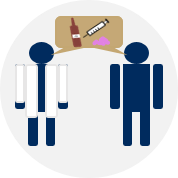
Pennsylvania SBIRT
The vision of Pennsylvania SBIRT (PA SBIRT) is to ensure that every patient in our primary care clinics receives the right SBIRT services by the right providers every time.
Screening, Brief Intervention, and Referral to Treatment (SBIRT)
SBIRT is a comprehensive and integrated public health approach to the delivery of early intervention and treatment services through universal screening for persons with substance use disorders (SUD) and those at risk of developing these disorders.

Screening
The use of validated procedures to quickly assess patient substance use risk and select appropriate care.

Brief Intervention
A 5-15 minute discussion that aims to increase patient understanding of the risks and build toward behavior change.

Referral to Treatment
A linking of appropriate patients to appropriate SUD treatment (specialty care).
Pennsylvania SBIRT (PA SBIRT)
Pennsylvania Screening, Brief Intervention, and Referral to Treatment (PA SBIRT) is a five-year initiative that will provide SBIRT services to over 20,000 patients throughout the Commonwealth. The project is directed by the Pennsylvania Department of Drug and Alcohol Programs (DDAP) and The University of Pittsburgh School Of Pharmacy, Program Evaluation and Research Unit (PERU). Funding for the project is granted through the Substance Abuse and Mental Health Services Administration (SAMHSA) Center for Substance Abuse Treatment (CSAT). All data is collected and reported in accordance with the Government and Performance Results (GPRA) Act of 2010.
Why Practice SBIRT?
Substance
use disorders (SUDs) and harmful drug and alcohol use are increasing problems
in the United States.
The 2018 National Survey on Drug Use and Health estimated that:
- 67.1 million individuals (24.5% of the U.S. population, aged 12 and older) are misusing alcohol.
- 11.7 million individuals (21.0% of the U.S. population, aged 12 and older) are misusing drugs.
- 20.3 million individuals (7.4% of the population) meet criteria for a DSM-IV SUD.
Misuse of alcohol and other drugs is significantly associated with medication adherence problems, overdose deaths, trauma and injury, and poor health outcomes (i.e., stroke, heart attacks, diabetes, etc.). A significant proportion of patients who misuse alcohol or drugs are likely to be present in different healthcare settings. It is estimated that:
- 23.4% of primary care patients in the U.S., aged 18 and older, are misusing alcohol or drugs.
- 39.9% of emergency department patients in the U.S., aged 18 and older, are misusing alcohol or drugs.
Substance misuse and SUDs are associated directly with increased healthcare and other social costs. The estimated total annual cost associated with substance misuse and SUD in United States is more than $740 billion, including costs associated with crime, lost work productivity, and health care. Despite this enormous cost, only 10% of patients with SUDs receive treatment.
SBIRT is one method for identifying and intervening with individuals earlier in
their risk trajectory. Research has demonstrated SBIRT’s many benefits,
including reductions in healthcare costs, severity of substance use, and trauma1-3.
In addition to these reductions, SBIRT application in healthcare sites can help
healthcare systems achieve optimal performance with the Healthcare
Effectiveness Data and Information Set (HEDIS) measure regarding initiation and
engagement of appropriate patients in alcohol or drug (AOD) treatment. SBIRT’s
demonstrated cost savings and health impacts have led federal agencies such as
Substance Abuse and Mental Health Services (SAMHSA), Veterans Administration,
Department of Defense, and the White House Office of National Drug Control
Policy to recommend routine SBIRT use. The United States Preventative Services
Task Force recommends SBIRT for alcohol and illicit drug misuse in adults (18+ years) and gave
it a “B” rating, which is the same rating assigned to screening for obesity,
diabetes, and breast cancer.
(1) Barbosa, C., Cowell, A., Bray, J., & Aldridge, A. (2015). The cost-effectiveness of alcohol screening, brief intervention, and referral to treatment (SBIRT) in emergency and outpatient medical settings. J Subst Abuse Treat, 53, 1-8. doi:10.1016/j.jsat.2015.01.003 (2) Bray, J. W., Del Boca, F. K., McRee, B. G., Hayashi, S. W., & Babor, T. F. (2017). Screening, Brief Intervention and Referral to Treatment (SBIRT): rationale, program overview and cross-site evaluation. Addiction, 112 Suppl 2, 3-11. doi:10.1111/add.13676 (3) Babor, T. F., Del Boca, F., & Bray, J. W. (2017). Screening, Brief Intervention and Referral to Treatment: Implications of SAMHSA's SBIRT initiative for substance abuse policy and practice. Addiction, 112 Suppl 2, 110-117. doi:10.1111/add.13675
Implementation Model
PA SBIRT bases implementation efforts on the Systems Transformation Framework (STF). This model uses a vision-focused approach to evaluate health system environments for maximized adaptation and growth potential. Technical assistance for PA SBIRT project sites is anchored to key STF system health domains. Project sites experience an integrated continuum of involved and supportive guidance from initial needs assessment through post-grant sustainability planning.
Read more about the System Transformation Framework
Evaluation Processes
Ongoing Continuous Quality Improvement (CQI) activities occur on a weekly basis, including weekly calls, weekly proficiency checklists, and weekly GPRA tracking. GPRA data is analyzed on a monthly basis in order to identify areas for continued improvement. A more in-depth process and outcome review is completed on a yearly basis.


